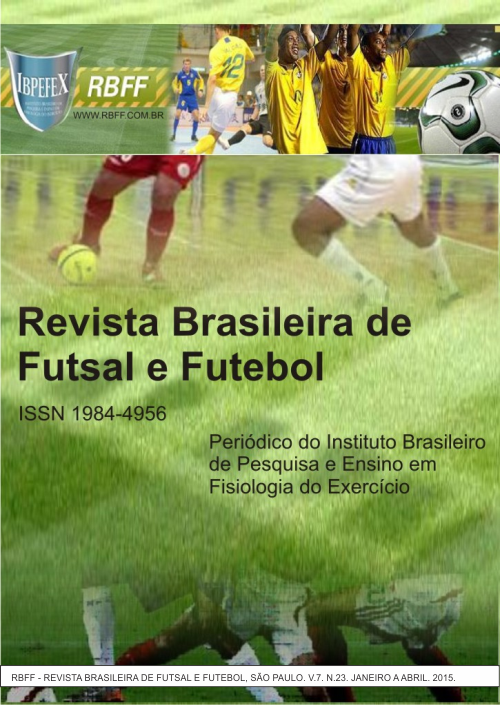Effect of selective loads periodization on incidence of injuries in professional female Futsal players during competitive season
Abstract
This study evaluated the effect of selective loads periodization on incidence of injuries in professional female Futsal players during competitive season. Twelve elite female Futsal players from Kindermann team (Brazil) participated in the study. The training was divided in four periods (preparatory, competitive, final competitive and transition period) and composed of 10 mesocycles. Mesocycles were composed of 4 weeks, divided in 4 microcycles of 7 days. Physical capacities changed in each training mesocycle. Were evaluated: percentages of the application of training in physical capacities and technical/tactical training in each mesocycle, training volume of the physical capacities of each mesocycle and incidence of injuries in the preparatory period (PP), competitive period (CP) and final preparatory period (FCP). Results showed that a) in the PP aerobic and muscular endurance (40%), lower limb flexibility (20%), muscle power (20%), agility/speed (20%) and submaximal strength (15%) were developed; b) in the CP and FCP had more emphasis on technical and tactical structures (60%) and maintained physical capacities, changing slightly the volume and intensity and c) injuries total was 17%. Selective loads periodization is adequate and attends the requirements of the sport decreasing the incidence of injuries during competitive season in female Futsal players.
References
-Abrahao, G.S.; Caixeta, L. F.; Barbosa, L. R.; Siqueira, D. P.; Carvalho, L. C.; Matheus, J. P. Incidência das lesões ortopédicas por segmento anatômico associado à avaliação da frequência e intensidade da dor em uma equipe de futebol amador. Brazilian Journal of Biomotricity. Vol. 3. p. 152-158. 2009.
-Barbosa, L. O. Fundamentos da elaboração de critérios de classificação dos modelos de periodização do treinamento esportivo. In: Congresso Internacional De Atividade Física, Saúde E Esporte -Conafise, 1.Rio de Janeiro. Anais... Fitness & Performance Journal, Vol. 3. p. 384-384. 2004.
-Carraveta, E. O enigma da prepara física no futebol. Porto Alegre. Age, 2009.
-Cetolin, T.; Foza, V. Periodização no Futsal: descrição da utilização da metodologia de treinamento baseada nas cargas seletivas. Brazilian Journal of Biomotricity. Vol. 4. Núm. 1. p. 24-31. 2010.
-Cruz, R. A. R. S. Efeitos de três programas de treinamento sobre variáveis motoras de escolares praticantes de futsal. Dissertação de Mestrado. UNIMEP. Piracicaba. 2011.
-Dantas, E. H. M. A prática da preparação física. 5ªedição. Rio de Janeiro. Editora Shape.2003.
-FIFA (2006). Futsal and beach soccer enjoying rising interest, FIFA research shows. May 10, 2007.fromhttp: //www.fifa.com/en/media/index/0,1369,122047,00.html.
-Gayardo, A.G.; Matana, S.B.; Silvs, M.R. Prevalence of injuries in female athletes of brazilian futsal: A retrospective study. Revista Brasileira de Medicina do Esporte. Vol. 18. Núm. 3. p. 186-189. 2012.
-Gomes, A. C. Treinamento desportivo: estruturação e periodização. Porto Alegre.Artmed. 2002.
-Junge, A.; Dvorak, J.; Graff-baumann, T.; Peterson, L. Football injuries during FIFA tournaments and the Olympic Games, 1998-2001. Development and implementation of an injury-reporting system. American Journal of Sports Medicine. Vol. 32. p. 80-89. 2004.
-Martins, C. M. L., Feitoza, P. M., Silva, F. M. As principais tendências de planejamento do treino: uma revisão bibliográfica. Revista Treinamento Desportivo. Vol. 4. Núm. 2. p. 71-80.1999.
-Moreira, A., Okano, A. H., Souza, M., Oliveira, P. R., Gomes, A. C. Changes for speed and strength measures with selective loads system in basketball players during a mesocycle. Revista Brasileira de Ciencias e Movimento. Vol. 13. Núm. 2. p. 7-15. 2005.
-Moreno, J. I. M. Clarificación de conceptos relacionados con el entrenamiento deportivo. Escuela Abierta. Vol. 7. p. 55-71. 2004.
-Porta, J., Sanz, D. Periodisation in top level men’stennis. Coaching & Sport Science Review. Vol. 36. p. 12-13. 2005.
-Roetert, P.; Reid, M.; Crespo, M. Introduction to Modern Tennis Periodisation. Coaching & Sport Science Review. Vol. 36. p. 2-3. 2005.
-Salles, J.G.C.; Moura, H.B. Indoor Football-Futsal. In Da Costa, L.P. (Org.), Atlas do Esporte no Brasil. Rio de Janeiro. Shape, p. 343. 2013.
-Simoes, A. C. Mulher e Esporte: mitos e verdades. São Paulo. Manole. 2003.
-Tubino. M. J. G., Moreira, S. B. Metodologia científica do treinamento desportivo. 13ªedição. Rio de Janeiro. Shape. 2003.
-Verkhoshanski, Y. V. Principles for a rational organization of the training process aimed at speed development. Revista Treinamento Desportivo. Vol. 4. Núm. 1. p. 3-7. 1999.
-Young, W., Elliott, S. Acute effects of static stretching, proprioceptive neuromuscular facilitation stretching, and maximum voluntary contractions on explosive force production and jumping performance. Research Qhaterly for Exercise and Sport. Vol. 72. p. 273-279. 2001.
Authors who publish in this journal agree to the following terms:
- Authors retain the copyright and grant the journal the right of first publication, with work simultaneously licensed under the Creative Commons Attribution License BY-NC which allows the sharing of the work with acknowledgment of the authorship of the work and initial publication in this journal.
- Authors are authorized to enter into additional contracts separately for non-exclusive distribution of the version of the work published in this journal (eg, publishing in institutional repository or book chapter), with acknowledgment of authorship and initial publication in this journal.
- Authors are allowed and encouraged to post and distribute their work online (eg, in institutional repositories or on their personal page) at any point before or during the editorial process, as this can bring about productive change as well as increase impact and impact. citation of published work (See The Effect of Free Access).





